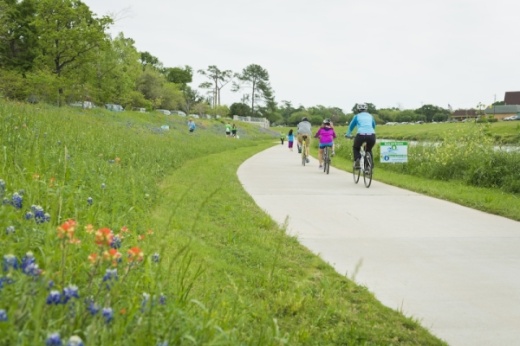In 30 years they hope to see all structures removed from Houston’s floodway—the most frequently flooded area of the city—a total of 375,000 new homes built across all income levels and equal life expectancy across all ZIP codes regardless of socioeconomic status.
A newly adopted resilience strategy outlines goals for everything from housing to disaster preparedness to economic disparities in the city and will serve as a guiding strategy for new policies and developments, Mayor Sylvester Turner said at a press conference announcing his signing of an executive order to enact the plan.
By the end of 2020, Turner said the city plans to hire a resilience officer assigned to each of the city’s departments to ensure new initiatives in all areas adhere to the framework, which took over two years to develop.
“We have to be intentional and move with the greatest sense of urgency,” Turner said. “We’re not going to build this resilient city in four years but this plan is what brings it all together."
Some of the goals are part of initiatives the city has already committed to achieving, such as going carbon neutral by 2050 under the Paris Climate Agreement; reducing traffic deaths to zero under the city’s Vision Zero plan; and constructing a network of trails and greenspace along all of Houston’s bayous.
Reducing emissions will need to come from partnering with existing energy industry leaders and enticing new industries to the city, Turner said.
“Progressing Houston’s climate and economic resilience goals demonstrates a clear commitment to being a leader through the energy transition," said Jason Klein, Shell Oil Vice President of US Energy Transition Strategy.
Shell Oil contributed $1.8 million toward funding the Resilient Houston strategy.
Building off of the city’s Complete Communities program, which aims to promote equitable investment in underserved communities, such as Gulfton, Acres Homes, Sunnyside and Kashmere Gardens, the resilience framework calls for 50 neighborhood-specific plans by 2030.
Investment toward achieving the goals outlined in the plan will have to come from both the public and private sector, Turner said. By 2040, the city aims for $50 billion in funding for recovery and mitigation projects. Much of this funding could go towards home buyouts, a strategy emphasized in a companion study to the resilience plan released Jan. 30.
In three frequently-flooded neighborhoods, the study documented roughly 6,000 residents living within the floodway. “Some of these are distant moonshots and some are achievable metrics," Houston Chief Resilience Officer Marissa Aho said.
Below are some of the goals outlined in the plan.
2020:
-Hire 20,000 youth summer jobs
-Hire a resilience officer in every city department
2025:
-Conduct 500,000 disaster preparedness trainings for Houston residents
-$5 million in investments for local artists for resilience awareness projects
-Construct 500 miles of trails and bike lanes
-Construct 100 new storm water infrastructure projects
2030:
-Reduce traffic fatalities to zero
-Develop 50 new neighborhood plans
-Plant 4.6 million trees
-Remove all habitable structures from the floodway
-Ensure 100% of Houstonians have access to accurate, real time emergency alerts
2040:
-Invest $50 billion in major recovery, mitigation and modernization projects
2050:
-375,00 new homes across all income levels
-Achieve Carbon Neutral status
-Eliminate geographic disparities in life expectancy
-Hire 20,000 youth summer jobs
-Hire a resilience officer in every city department
2025:
-Conduct 500,000 disaster preparedness trainings for Houston residents
-$5 million in investments for local artists for resilience awareness projects
-Construct 500 miles of trails and bike lanes
-Construct 100 new storm water infrastructure projects
2030:
-Reduce traffic fatalities to zero
-Develop 50 new neighborhood plans
-Plant 4.6 million trees
-Remove all habitable structures from the floodway
-Ensure 100% of Houstonians have access to accurate, real time emergency alerts
2040:
-Invest $50 billion in major recovery, mitigation and modernization projects
2050:
-375,00 new homes across all income levels
-Achieve Carbon Neutral status
-Eliminate geographic disparities in life expectancy





